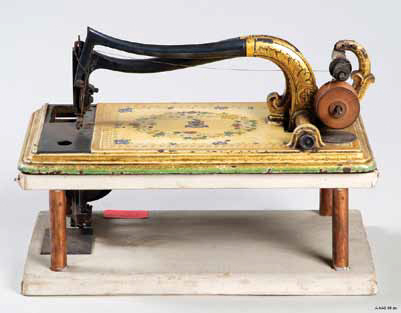To Protect and Conserve
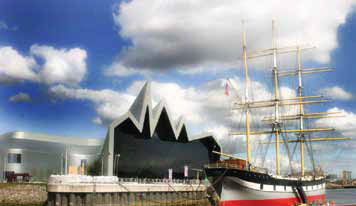
The Riverside Museum, Glasgow
It is difficult to know where to begin when asked about Glasgow Museums' sewing machine collection. It is so diverse, with so many jewels and there is so much exciting research still to be done. What a wonderful dilemma to have, however. I thought it best therefore to begin with my role in caring for the collection.
Where the River Kelvin meets the Clyde stands an infant building with irregular jagged points marking what has become an iconic Glasgow roofline. The building is an infant only in age; it is a relative giant in its surroundings. My desk is situated behind the glazed gable facing north and from this privileged position, I can look out over the regular flow of visitors to the Riverside Museum.
It is here that I read the ISMACS digest and carry out most of my work. However, there are only three sewing machines in Riverside Museum displays, all Singer, which leads me to visit Glasgow Museums Resource Centre regularly. It is here that the majority of our over- 153 sewing machines are housed.

Kimball & Morton 'Lion', 1902 hand version, based mechanically on the Singer 28
We also have contemporary cans of sewing machine oil, screwdrivers, thread spools, toy sewing machines, attachments, needles, parts and shuttles.
The Centre [GMRC] contains corridor upon corridor flanked with doors leading to rooms, dubbed 'pods'. Each pod houses myriad objects from taxidermy to towering suits of armour; fine art; sculptures; photographs; fossils; trams; bicycles; crockery; musical instruments and technology. Here, too, we have an archive and library which boasts a great many books and items of ephemera relating to sewing machines, their history and use. It is in Pod 8 that I spend most of my time and it is where you will find our most splendid sewing machines.
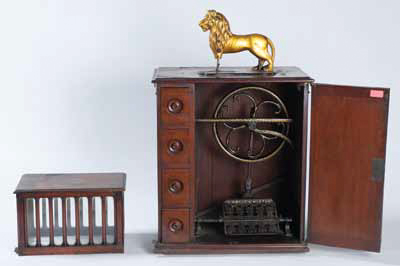
The earlier cabinet treadle 'Lion' is a a registered design of 1868; reciprocating shuttle, based on the Singer 12. Note the cute cage cover
I well remember my first visit here to GMRC and the moment I saw our two exquisite Kimball and Morton Lions.
The claim made by the Glasgow manufacturers of the Lion was that it was at once the handsomest and the best working sewing machine in existence. I have to agree that they are two of the most striking machines I've ever seen and immediately draw visitors to move in for a closer look. They were by no means the only machines to pique my interest that day. We also have a large industrial sewing machine manufactured by The British United Shoe Machinery Co Ltd that is really quite something. [TEMP.17967], as well as a Stockwell Brothers' Howe hand machine [PP.1975.207]. Dating from 1872-75, it was probably assembled at their works here in Glasgow.
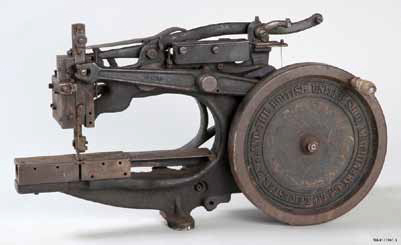
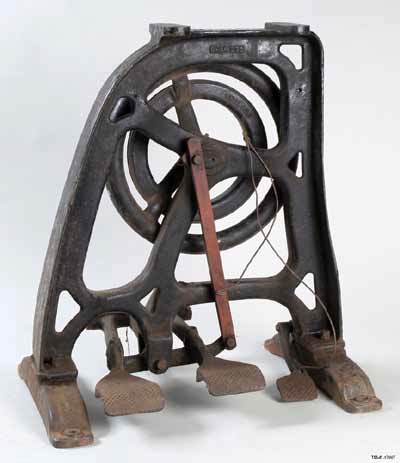
The British United Shoe Machinery Co.'s boot closing machine and its mighty, two-footed treadle
Visitors can telephone and book onto general and specialist tours at GMRC. Anybody who would like to be shown the sewing machine collection in detail need only ask and it can be arranged. If there are particular models of interest, it's best to mention them prior to the visit however, as some may be in another location. Many of these machines can then be brought over for viewing. A couple of my favourites in the collection include a Singer Improved Family domestic, serial no. 10654178. [T.1982.19], commissioned March 25, 1892.
Another is a mounted treadle head "made by Messrs Grover and Baker, Boston. Patents 1846-61. With cotton reel. [A.1947.99.ac]". I currently have very little information about this machine and look forward to researching it soon.
Yet one more beautiful machine in our stores is a 'New England', sold in England at 55 shillings by James G Weir, London, in wooden box, circa 1870, and made by Raymond, in Canada.
You will have noticed that beside each sewing machine I mention, I have included a number in brackets. This is the accession number assigned to each machine. Accession numbers are what allow us to track the 2.4 million objects that belong in Glasgow Museums' vast collections. We have a comprehensive database that allows me quick and easy access to records by inputting the appropriate number or a description of the object I am looking for.
It is my job to update each record with an accurate description, date of manufacture and to note anything that sets the machine apart in terms of its place in the history of the sewing machine. Glasgow Museums also hosts an online database that can be searched and browsed by the public. It is called Collections Navigator and is currently being populated by Glasgow Museums' many curators. It is a huge task and we're not quite finished yet but there are a great many fascinating objects ready for viewing already. You can visit the Navigator at: http://www.glasgowlife.org.uk/ museums/collections-research/online-collectionsnavigator/ Pages/home.aspx#
I have already included our Kimball and Morton Lions on Navigator and it is my aim to update the sewing machine collection as I progress with my research.
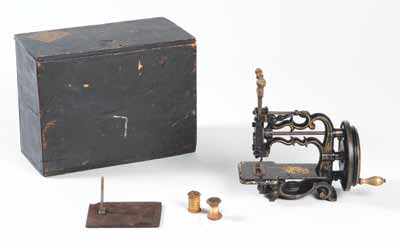
The Weir Made by Raymond
One of the purposes of museum collections is to create a safe and caring environment for important objects that communicate elements of our past. We have a team of dedicated conservators with a variety of specialialities who care for and protect the physical nature of the collection.
The wonderful conservator who cares for our sewing machines, as well as all sorts of technological devices and mechanisms, is called Jacek Wiklo and together we hope to release the many machines that are currently imprisoned in cases. It is one of Jacek's many jobs to regularly clean and maintain each and every sewing machine ensuring that no further degradation is allowed to take place. An example of his basic procedures when looking at the sewing machine collection is:
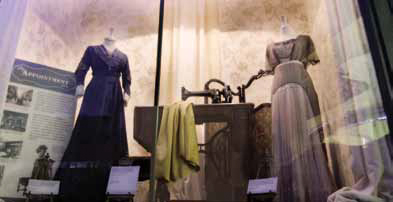
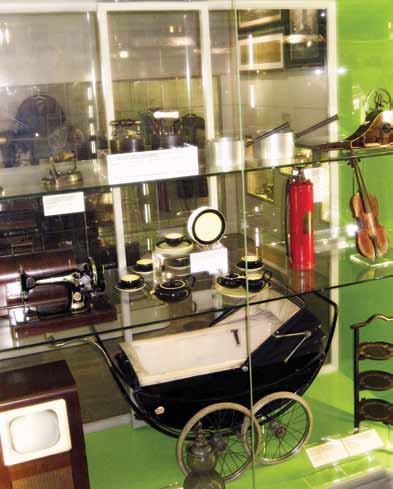
Two machines that were conserved for display at The Riverside Museum [top: T.1974.45-Singer R 175019] and [TEMP.17939-Singer portable]
•Carry out a condition assessment of each machine (this includes creating a description of the condition, photography, pest checking, labelling, input of this information with the date onto our database etc.)
•Cleaning/removal of dust and dirt using a vacuum and wide range of brushes.
•Consolidation of loose paint if necessary.
•If necessary deep cleaning is carried out to remove stubborn dirt or grease using white spirit, brushes, cotton swabs, scalpels etc.
•Removing (mechanically or chemically) corrosion from metal parts if necessary.
•Checking for loose elements and securing any that are found.
•Applying protective layers of wax or lacquer (depending on the material that the object is made from)
•If a machine is to go on display there may be cause to protect moving parts and/or ensure sharp edges etc. are housed in such a way as to avoid accidents.
I am systematically working my way through the collection and adding information to our records for each machine. It makes for truly fascinating research. I am lucky to have The Mitchell Library, one of Europe's largest reference libraries, nearby. They have copies of many journals that have been invaluable as primary source material and, of course, I have now discovered ISMACS which is proving equally invaluable.
I have produced a list (though by no means complete) of what we have in the collection that is currently available for viewing. Let me know if you would like a copy. Please note that I have copied the information from our database and it is not always accurate – part of my job is to go through and make additions and amendments. With this in mind, if you have particular knowledge of a machine in our collection – please get in touch. (HR)







